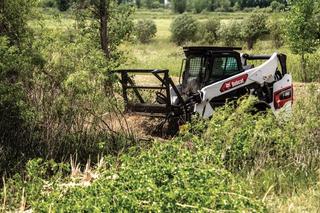Compact Track Versus Skid-Steer Loaders
Eight Tips to Make the Right Choice for Your Acreage


Whether you’re operating a small homestead, maintaining a sizable estate, or overseeing a landscaping project, having the right compact loader can make all the difference. Skid-steer loaders (SSLs) and compact track loaders (CTLs) are versatile machines ideal for a variety of tasks on acreages of all sizes.
However, with numerous new models and features available on the market, selecting the perfect compact loader for your acreage can be a challenge.
Here are eight tips to help you navigate the selection process and choose your next (or first) skid-steer loader or compact track loader for your acreage.
Assess your needs
Take stock of what tasks you need to complete on your acreage. For example, if you routinely need to clean out a livestock barn, you may want to consider a skid-steer loader. The machine’s travel speed, tires and tight turning radius make it particularly maneuverable and nimble.
However, if you are often clearing brush and forestry debris from your property, the power and performance of a compact track loader will help you make quick work of those types of tasks.
Determine Load Capacity
Load capacity is a crucial factor when selecting a loader. Consider the heaviest loads you’ll need to lift and transport on your acreage. Skid-steer loaders typically have lower load capacities compared to compact track loaders.
If you anticipate handling heavier materials or loads on your acreage, a compact track loader might be the better choice.
Evaluate Your Terrain
Acreages can have varied terrain conditions, from flat grasslands to rugged hillsides. Assess the terrain of your property to determine whether you need a skid steer loader or a compact track loader. How? While skid-steer loaders are best suited for flat surfaces and paved areas, compact track loaders offer better traction and flotation on uneven, rocky or soft ground, thanks to their tracked undercarriage.
Consider Attachments
Skid-steer and compact track loader attachments allow you to tackle diverse tasks without investing in multiple pieces of equipment. Common attachments include buckets, forks, augers, grapples and brush cutters. We recommend that as part of your equipment needs evaluation, you prioritize a loader that can accommodate the attachments you need for your specific tasks.
In addition, make sure to pair the right hydraulics with your attachment needs. Consider a loader that comes equipped with multiple hydraulic flow options, like the Bobcat S86 skid-steer loader or T86 compact track loader. These are the only compact loaders in the industry that deliver three hydraulic flow options, including super flow. This option allows you to tackle the most demanding applications with compatible attachments.
Evaluate Size and Maneuverability
The size of your acreage and the space available for maneuvering are important considerations. Both skid steer and compact track loaders have a tight turning radius, making them suitable for confined spaces, narrow pathways or limited clearance areas on your property. However, if you have wide open spaces and soil compaction is of consideration, a compact track loader may be the better choice.
Assess Comfort
Operator comfort and visibility are essential for efficiency and safety during long hours of operation. Both skid-steer loaders and compact track loaders can come equipped with spacious and ergonomic cabs that provide ample legroom, adjustable seating and easy-to-reach controls.
All-around visibility from the cab ensures better maneuverability and allows operators to work with precision, especially in tight spaces or crowded environments. In addition, visibility can be enhanced with a clear-side cab option.
Factor in Maintenance Requirements
Proper maintenance is essential for prolonging the lifespan of your loader and ensuring optimal performance. Consider the maintenance requirements and service intervals of different models, including accessibility for routine checks and servicing. Choose a loader with user-friendly maintenance features and reliable customer service and support from your local dealer.
Budget Considerations
Finally, establish a budget for your purchase and weigh the upfront cost against the long-term value and productivity of the loader. While price is an important factor, it’s also essential to consider the overall quality, durability, and performance of the machine. Investing in a high-quality loader up front may yield greater returns in terms of efficiency, reliability and resale value.
By thoroughly evaluating these factors and comparing different models, you can make an informed decision that maximizes productivity and enhances the efficiency of your operations on your acreage.
Thanks to Bobcat for supplying these helpful tips.
Tags:Tool Time

Acreage Life is part of the Catalyst Communications Network publication family.















